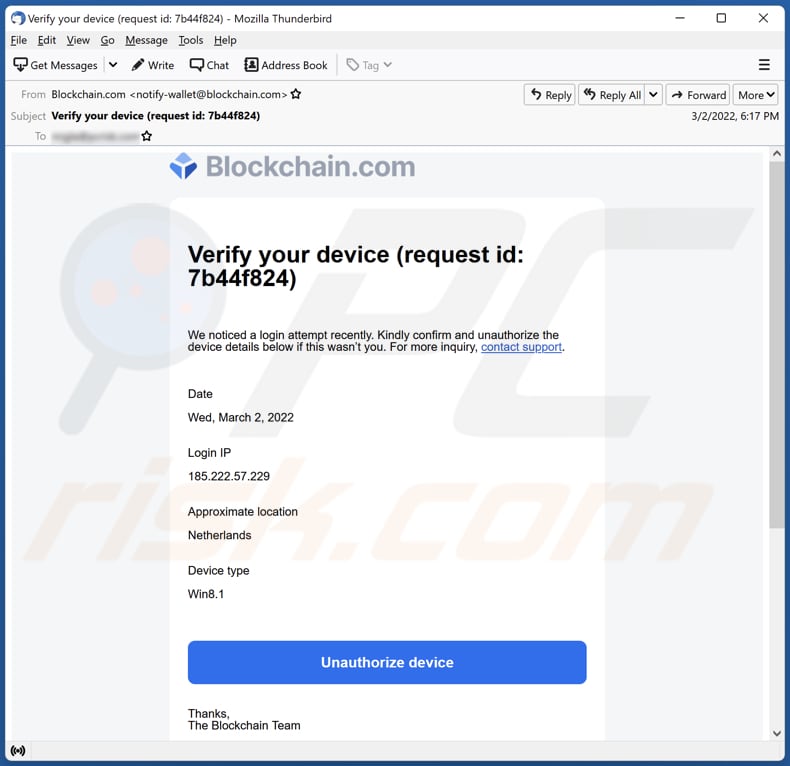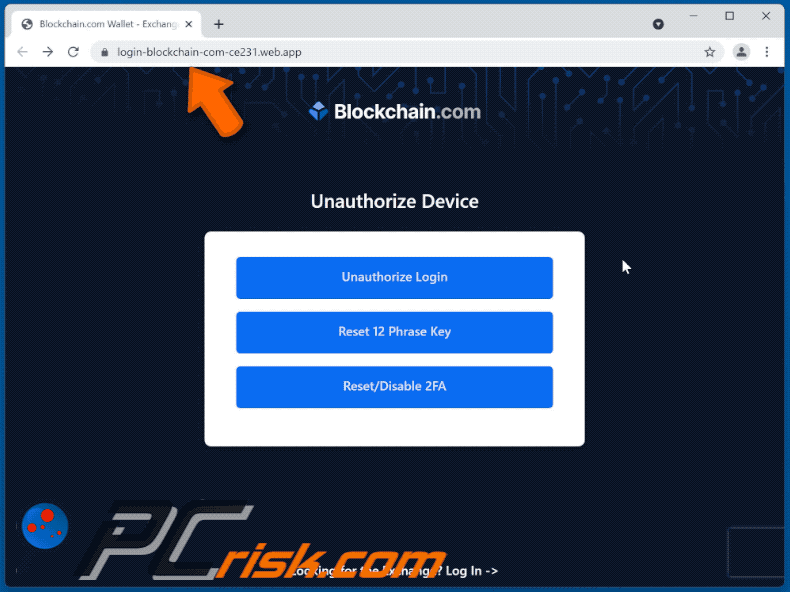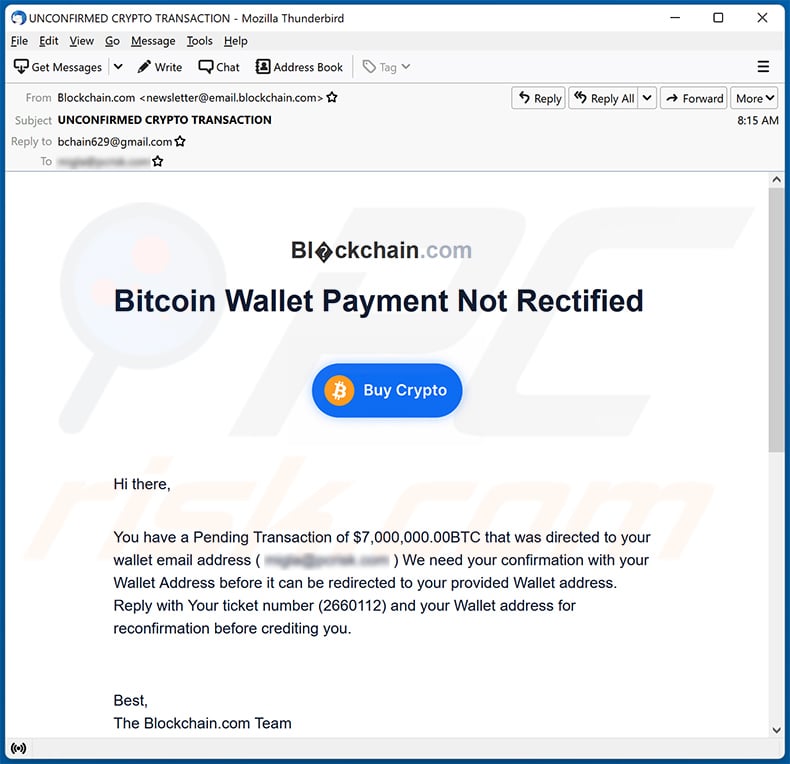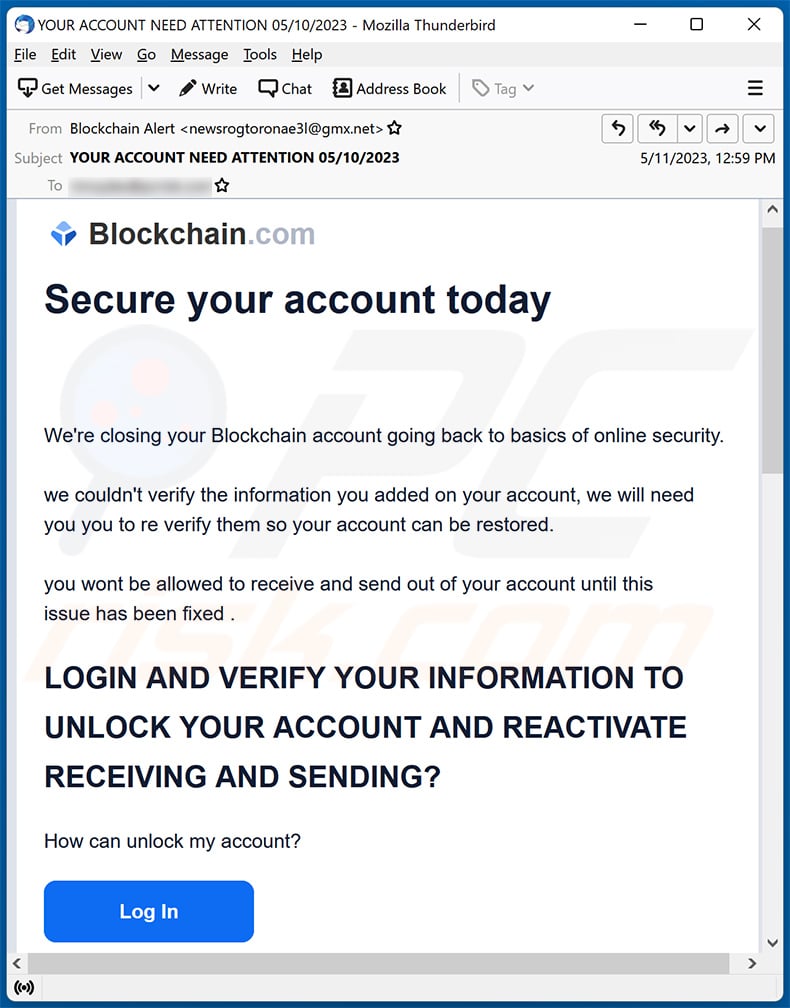How to spot scams like the Blockchain.com phishing email
Phishing/ScamAlso Known As: Blockchain.com phishing email
Get free scan and check if your device is infected.
Remove it nowTo use full-featured product, you have to purchase a license for Combo Cleaner. Seven days free trial available. Combo Cleaner is owned and operated by RCS LT, the parent company of PCRisk.com.
What is the "Blockchain[.]com email scam"?
We have examined this email and learned that this is a fake notification letter regarding an unauthorized login attempt. It contains a link to a phishing site (disguised as a legitimate blockchain[.]com website). Scammers behind this email attempt to steal blockchain[.]com accounts.

Blockchain[.]com phishing email in detail
Blockchain[.]com is a legitimate company that provides a platform for holding, using, and managing crypto assets (and studying cryptocurrency transactions). It has nothing to do with this phishing email. The email claims that a recent login attempt has been noticed and asks to unauthorize (or confirm) the device via the presented website.
The presented "Unauthorize device" hyperlink opens a phishing website, a fake blockchain[.]com with a different URL address and design. Scammers use it to trick unsuspecting visitors into providing email addresses (or wallet IDs) and secret recovery phrases. Their goal is to hijack crypto wallets and steal cryptocurrency.
| Name | Blockchain[.]com Email Scam |
| Threat Type | Phishing, Scam, Social Engineering, Fraud |
| Fake Claim | A suspicious login attempt has been noticed on blockchain[.]com website |
| Related Domain | login-blockchain-com-ce231.web[.]app |
| Detection Names (login-blockchain-com-ce231.web[.]app) | Avira (Phishing), Combo Cleaner (Phishing), ESET (Phishing), Kaspersky (Phishing), Sophos (Malware), Full List Of Detections (VirusTotal) |
| Disguise | Letter from Blockchain[.]com team |
| Symptoms | Unauthorized online purchases, changed online account passwords, identity theft, illegal access of the computer. |
| Distribution methods | Deceptive emails, rogue online pop-up ads, search engine poisoning techniques, misspelled domains. |
| Damage | Loss of sensitive private information, monetary loss, identity theft. |
| Malware Removal (Windows) |
To eliminate possible malware infections, scan your computer with legitimate antivirus software. Our security researchers recommend using Combo Cleaner. Download Combo CleanerTo use full-featured product, you have to purchase a license for Combo Cleaner. 7 days free trial available. Combo Cleaner is owned and operated by RCS LT, the parent company of PCRisk.com. |
Emails of this type in general
Typically, phishing emails are disguised as official (or urgent/important) letters from legitimate companies or other entities. They contain a link designed to open a phishing website asking to provide credit card details, login credentials, and other sensitive information.
More examples of phishing emails are "Signed In To From A New Windows Device Email Scam", "Your Password Expires Today Email Scam", "Request To Close Your Email Scam". Another popular way to misuse emails for malicious purposes is to deliver malware.
How do spam campaigns infect computers?
Emails used to deliver malware can cause damage in two ways: via malicious attachments or website links. In both cases, computers get infected after executing a malicious file. Usually, threat actors use MS Office, PDF or other documents, JavaScript files, archives, executables, and other files to trick users into executing malware.
How to avoid installation of malware?
Do not trust irrelevant emails that contain attachments or links. Especially when such emails are received from unknown or suspicious addresses. Opening files or links in emails of this kind can cause computer infections. Use official pages and direct links as sources for downloading files and programs. Avoid using other sources.
Keep the installed software up to date. Update (and activate) it using implemented functions or tools provided by the official developer. If you've already opened malicious attachments, we recommend running a scan with Combo Cleaner Antivirus for Windows to automatically eliminate infiltrated malware.
Text presented in the blockchain[.]com phishing email:
Subject:
Blockchain.com
Verify your device (request id: 7b44f824)
We noticed a login attempt recently. Kindly confirm and unauthorize the device details below if this wasn’t you. For more inquiry, contact support.
Date
Wed, March 2, 2022
Login IP
185.222.57.229
Approximate location
Netherlands
Device type
Win8.1
Unauthorize deviceThanks,
The Blockchain Teamdownload on the app store
get it on google play
© Blockchain[.]com
Appearance of the phishing website used to steal blockchain[.]com accounts (GIF):

Another example of blockchain.com-themed spam email used for phishing purposes:

Text presented within:
Subject: UNCONFIRMED CRYPTO TRANSACTION
Blockchain.com
Bitcoin Wallet Payment Not Rectified
Hi there,
You have a Pending Transaction of $7,000,000.00BTC that was directed to your wallet email address ( ********* ) We need your confirmation with your Wallet Address before it can be redirected to your provided Wallet address. Reply with Your ticket number (2660112) and your Wallet address for reconfirmation before crediting you.
Best,
The Blockchain.com TeamBlockchain.com
Blockchain Access UK Ltd
2 Tallis Street
London EC4Y 0AB
Another example of blockchain.com-themed spam email promoting a phishing site:

Text presented within:
Subject: YOUR ACCOUNT NEED ATTENTION 05/10/2023
Blockchain.com
Secure your account today
We're closing your Blockchain account going back to basics of online security.we couldn't verify the information you added on your account, we will need you you to re verify them so your account can be restored.
you wont be allowed to receive and send out of your account until this issue has been fixed .
LOGIN AND VERIFY YOUR INFORMATION TO UNLOCK YOUR ACCOUNT AND REACTIVATE RECEIVING AND SENDING?How can unlock my account?
Log InBest,
The Blockchain.com TeamWas this email helpful? ?? ??
© 2023 Blockchain.com Group Holdings, Inc.
Instant automatic malware removal:
Manual threat removal might be a lengthy and complicated process that requires advanced IT skills. Combo Cleaner is a professional automatic malware removal tool that is recommended to get rid of malware. Download it by clicking the button below:
DOWNLOAD Combo CleanerBy downloading any software listed on this website you agree to our Privacy Policy and Terms of Use. To use full-featured product, you have to purchase a license for Combo Cleaner. 7 days free trial available. Combo Cleaner is owned and operated by RCS LT, the parent company of PCRisk.com.
Quick menu:
- What is Blockchain.com phishing email?
- Types of malicious emails.
- How to spot a malicious email?
- What to do if you fell for an email scam?
Types of malicious emails:
![]() Phishing Emails
Phishing Emails
Most commonly, cybercriminals use deceptive emails to trick Internet users into giving away their sensitive private information, for example, login information for various online services, email accounts, or online banking information.
Such attacks are called phishing. In a phishing attack, cybercriminals usually send an email message with some popular service logo (for example, Microsoft, DHL, Amazon, Netflix), create urgency (wrong shipping address, expired password, etc.), and place a link which they hope their potential victims will click on.
After clicking the link presented in such email message, victims are redirected to a fake website that looks identical or extremely similar to the original one. Victims are then asked to enter their password, credit card details, or some other information that gets stolen by cybercriminals.
![]() Emails with Malicious Attachments
Emails with Malicious Attachments
Another popular attack vector is email spam with malicious attachments that infect users' computers with malware. Malicious attachments usually carry trojans that are capable of stealing passwords, banking information, and other sensitive information.
In such attacks, cybercriminals' main goal is to trick their potential victims into opening an infected email attachment. To achieve this goal, email messages usually talk about recently received invoices, faxes, or voice messages.
If a potential victim falls for the lure and opens the attachment, their computers get infected, and cybercriminals can collect a lot of sensitive information.
While it's a more complicated method to steal personal information (spam filters and antivirus programs usually detect such attempts), if successful, cybercriminals can get a much wider array of data and can collect information for a long period of time.
![]() Sextortion Emails
Sextortion Emails
This is a type of phishing. In this case, users receive an email claiming that a cybercriminal could access the webcam of the potential victim and has a video recording of one's masturbation.
To get rid of the video, victims are asked to pay a ransom (usually using Bitcoin or another cryptocurrency). Nevertheless, all of these claims are false - users who receive such emails should ignore and delete them.
How to spot a malicious email?
While cyber criminals try to make their lure emails look trustworthy, here are some things that you should look for when trying to spot a phishing email:
- Check the sender's ("from") email address: Hover your mouse over the "from" address and check if it's legitimate. For example, if you received an email from Microsoft, be sure to check if the email address is @microsoft.com and not something suspicious like @m1crosoft.com, @microsfot.com, @account-security-noreply.com, etc.
- Check for generic greetings: If the greeting in the email is "Dear user", "Dear @youremail.com", "Dear valued customer", this should raise suspiciousness. Most commonly, companies call you by your name. Lack of this information could signal a phishing attempt.
- Check the links in the email: Hover your mouse over the link presented in the email, if the link that appears seems suspicious, don't click it. For example, if you received an email from Microsoft and the link in the email shows that it will go to firebasestorage.googleapis.com/v0... you shouldn't trust it. It's best not to click any links in the emails but to visit the company website that sent you the email in the first place.
- Don't blindly trust email attachments: Most commonly, legitimate companies will ask you to log in to their website and to view any documents there; if you received an email with an attachment, it's a good idea to scan it with an antivirus application. Infected email attachments are a common attack vector used by cybercriminals.
To minimise the risk of opening phishing and malicious emails we recommend using Combo Cleaner Antivirus for Windows.
Example of a spam email:

What to do if you fell for an email scam?
- If you clicked on a link in a phishing email and entered your password - be sure to change your password as soon as possible. Usually, cybercriminals collect stolen credentials and then sell them to other groups that use them for malicious purposes. If you change your password in a timely manner, there's a chance that criminals won't have enough time to do any damage.
- If you entered your credit card information - contact your bank as soon as possible and explain the situation. There's a good chance that you will need to cancel your compromised credit card and get a new one.
- If you see any signs of identity theft - you should immediately contact the Federal Trade Commission. This institution will collect information about your situation and create a personal recovery plan.
- If you opened a malicious attachment - your computer is probably infected, you should scan it with a reputable antivirus application. For this purpose, we recommend using Combo Cleaner Antivirus for Windows.
- Help other Internet users - report phishing emails to Anti-Phishing Working Group, FBI’s Internet Crime Complaint Center, National Fraud Information Center and U.S. Department of Justice.
Frequently Asked Questions (FAQ)
Why did I receive this email?
It likely happened because scammers have your email address in their database (typically, they obtain email addresses after data breaches). Either way, scammers send the same emails to all recipients - they do not target anyone in particular.
I have provided my personal information when tricked by this email, what should I do?
If you have provided your email address (or wallet ID) and secret recovery phrase, contact blockchain[.]com support team as soon as possible to see what they can do about it. If scammers have already stolen your crypto assets, it is unlikely that it will be possible to recover them.
I have downloaded and opened a file attached to an email used to deliver malware, is my computer infected?
If you have opened an executable file, your computer is likely already infected with malware. Although, MS Office documents, archives, and other files usually do not infect computers right after opening them.
I have read the email but did not open the attachment, is my computer infected?
No, reading/opening an email cannot cause damage. Thus, if you have not opened a malicious link or file, your computer is safe.
Will Combo Cleaner remove malware infections that were present in email attachment?
Yes, Combo Cleaner can detect and eliminate almost all known malware. It is important to mention that high-end malware can hide deep in the operating system. In such cases, it is required to run a full system scan to detect (and eliminate) malware.
Share:

Tomas Meskauskas
Expert security researcher, professional malware analyst
I am passionate about computer security and technology. I have an experience of over 10 years working in various companies related to computer technical issue solving and Internet security. I have been working as an author and editor for pcrisk.com since 2010. Follow me on Twitter and LinkedIn to stay informed about the latest online security threats.
PCrisk security portal is brought by a company RCS LT.
Joined forces of security researchers help educate computer users about the latest online security threats. More information about the company RCS LT.
Our malware removal guides are free. However, if you want to support us you can send us a donation.
DonatePCrisk security portal is brought by a company RCS LT.
Joined forces of security researchers help educate computer users about the latest online security threats. More information about the company RCS LT.
Our malware removal guides are free. However, if you want to support us you can send us a donation.
Donate
▼ Show Discussion